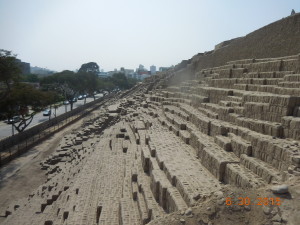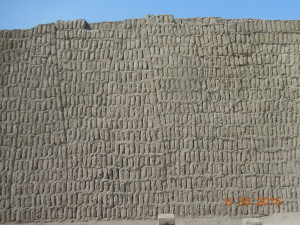Once upon a time the desert that is now Lima’s central Pacific coast, with 1/2″ of rain per year, was a thriving agricultural area with wetlands, forests and extensive fruit tree plantings watered by a complex irrigation system. The sea and all its wealth was there for the taking. No wonder the culture, now referred to as Lima (200-700 a.d.), thrived. Here they built Maranga, a city with 14 giant pyramids and 50 smaller public buildings spread over 4,000,000 square meters. Most of those marvels have been lost over the last two centuries as Lima expanded. The only major site remaining is a religious and administrative center known as Huaca Pucllana. Pucllana comes from the Quechua word meaning a site for games – in this case sacred games. Here the Lima people worshipped female goddesses representing the moon and the sea.
 Now surrounded by the up-market neighborhood of Milleflores, the six acre site is being excavated and restored. The huge central pyramid, 22 meters high, 500 meters long, 100 meters wide, rises in 7 levels, ascended by zigzag ramps. The genius of its builders is evident – after 1500 years it still stands in this land of horrendous
Now surrounded by the up-market neighborhood of Milleflores, the six acre site is being excavated and restored. The huge central pyramid, 22 meters high, 500 meters long, 100 meters wide, rises in 7 levels, ascended by zigzag ramps. The genius of its builders is evident – after 1500 years it still stands in this land of horrendous  earthquakes. It was built using the “bookshelf” technique – placing small rectangular adobe bricks (6 million of them) vertically leaving a space between, and putting plaster only on the upper and lower parts. This provided enough give to absorb centuries of shocks.
earthquakes. It was built using the “bookshelf” technique – placing small rectangular adobe bricks (6 million of them) vertically leaving a space between, and putting plaster only on the upper and lower parts. This provided enough give to absorb centuries of shocks.
The whole pyramid was once plastered and painted a pale yellow in honor of the moon goddess. Here priests presided over rituals including the sacrifice of young women.
 In about 700, the Lima people succumbed to the warlike Hwari who turned the top level of the pyramid into a burial site for their elites. Sixty five graves have been found so far, the mummies often accompanied by sacrificed victims as in this burial – two small children.
In about 700, the Lima people succumbed to the warlike Hwari who turned the top level of the pyramid into a burial site for their elites. Sixty five graves have been found so far, the mummies often accompanied by sacrificed victims as in this burial – two small children.
The area was part of the Inca empire from 1450 until the Spanish conquest in 1535 when the indigenous population was relegated to peripheral villages, and Lima, then known as Las Reyes, became the conquerers capital.
After climbing up and down Huaca Pucllana, we are more than ready to relax at La Gloria that evening. Check out the mouthwatering photos on their website – www.lagloriarestaurant.com

Leave A Comment